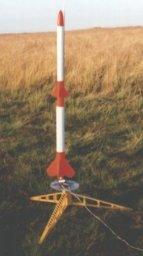Scratch Mark IV Original Design / Scratch Built
Scratch - Mark IV {Scratch}
Contributed by Darren Longhorn
| Manufacturer: | Scratch |
 This was my most ambitious rocket to date. By now I had found a shop in Leeds ( The Model Shop, 88 Cross Gates Road, Leeds, LS15 7NL Tel 0113 2646117) which had a reasonable selection of engines, even Ds, so I had to build a rocket which could fly one. I got a larger core from a roll of aluminium foil for the main body, and used the same sized tube as the MkII for the upper section. This meant that I could use the same nose cone, with the buzzer as the MkII. I had a balsa transition made to connect the two sections together. The fins were made of balsa using the same technique as the MkII ( 1mm thick for the upper section, 1.5mm for the lower) using a simple triangle for the upper section and a more complicated shape for the lower, which I copied from one of my sons toys.
This was my most ambitious rocket to date. By now I had found a shop in Leeds ( The Model Shop, 88 Cross Gates Road, Leeds, LS15 7NL Tel 0113 2646117) which had a reasonable selection of engines, even Ds, so I had to build a rocket which could fly one. I got a larger core from a roll of aluminium foil for the main body, and used the same sized tube as the MkII for the upper section. This meant that I could use the same nose cone, with the buzzer as the MkII. I had a balsa transition made to connect the two sections together. The fins were made of balsa using the same technique as the MkII ( 1mm thick for the upper section, 1.5mm for the lower) using a simple triangle for the upper section and a more complicated shape for the lower, which I copied from one of my sons toys.
The engine mount was made from a length of the same tube as the upper section, which is exactly right for D engines. The transition was permanently fixed to the upper section, which are attached to the lower section by the shock cord. A larger Estes parachute was attached to the transition.
The first time I flew it, it went up really well, very straight and high. We lost sight of it, but kept expecting to see the ejection charge and the parachute. Next thing we knew there was a loud 'thunk' and the rocket was embedded in the ground about 30m from where we were standing. Unfortunately a passer-by reached it first and gave it a good tug to pull it up, which caused more damage, and we were never able to locate the hole in the very tough springy grass. This was a pity because the nose cone is probably still there, about 20 centimeters underground! I thought I had bought engines without ejection charges, but later I realized I hadn't. I have since used the same engines in my Estes Phoenix, without problems, and have read much on the Internet about D engine ejection charges.
 This is what happens if you buy the wrong engine? No, crap engines.
This is what happens if you buy the wrong engine? No, crap engines.
We rebuilt it by making a clean cut ( where the white damaged area meets the orange fin section in the photo) and grafting on a new tube and nose cone. The next flight the ejection charge did fire, but still no parachute deployment. It turns out that there was a path back though the engine mount for the exhaust gases, so that's where they went. More spectacular damage this time including shattered fins, and again the top body tube written off.
Third time lucky! Well, partially. We rebuilt just in time for UKRA 98 held at Garlands. This was a great event, where I saw my first HPR rockets, but the weather was pretty poor. It actually redefined my definition of 'valid flying weather'!
The flight was perfect, straight up, despite the wind and the first successful parachute deployment. Unfortunately the wind caught the chute and blew it into the next county. Despite a search of the down wind fields we never found a trace. Still I always liked this rocket, and if I get the chance I might build a replica, now that the design bugs have been worked out.
Sponsored Ads
 |
 |











